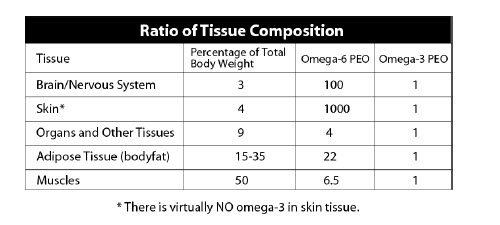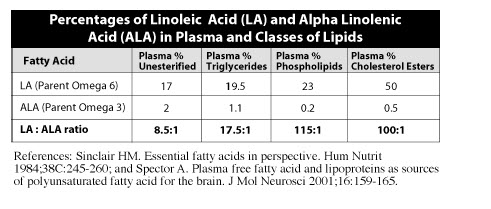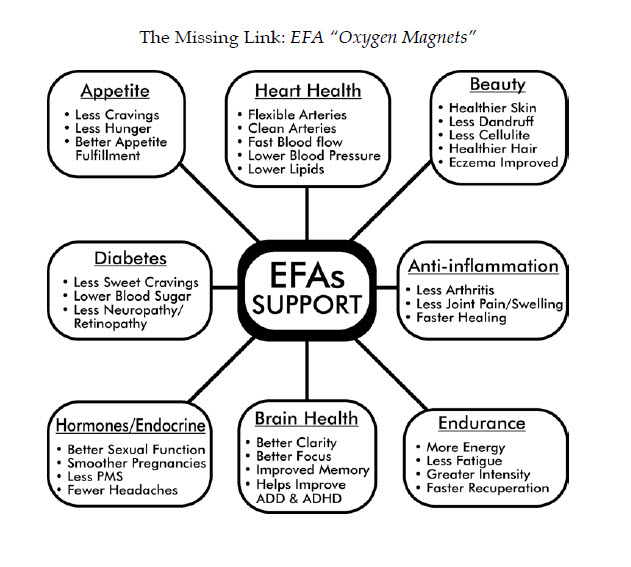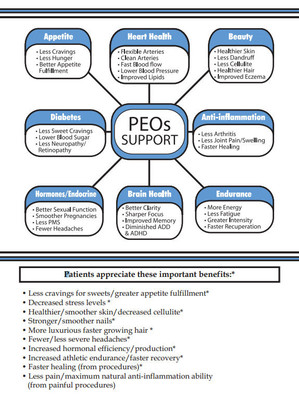The World’s Leading Physiologic EFA Expert — Prof. Brian Peskin
Mar 15th 2021
Prof. Brian Peskin is a world-leading scientist specializing in parent EFAs — termed PEOs — and their direct relationship to both cancer and cardiovascular disease.
While advancing the scientific understanding of the role of essential fatty acids in the body's metabolic pathways, he has concurrently developed a means for alleviating cancer's prime cause, as postulated by Nobel Prize-winner Otto Warburg, M.D., Ph.D., by increasing cellular oxygenation (The Hidden Story of Cancer, www.pinnaclepress.com). Amazingly, there is a fundamental cancer / heart disease connection, whereby the same physiologic solution solves both conditions. This information will lead to a new understanding of how to treat and prevent both cancer and heart disease. The basis for Peskin’s current work, grounded strictly in state-of-the-art science — in particular, physiology — can be found in his seminal work and peer-reviewed medical journal articles. Clinical physicians throughout the world have validated Prof. Peskin’s EFA recommendations.
In the most exciting development to date, Brian’s theoretical conclusions were recently and completely validated in a physiological experiment by precise instrumentation capable of measuring arterial compliance. This experiment (IOWA study) provided the first conclusive clinical proof and validation of Prof. Peskin's theory. Peskin Pharmaceuticals has a patent pending on the medicament that embodies this development.(The Peskin Omega supplement formula is available here.)
What is a Parent Essential Oil (PEO)?
There are only two (2) essential fatty acids, LA (parent omega-6) and ALA (parent omega-3).
They MUST come from food. To work properly, they MUST be NOT heated, chemically unprocessed, organically raised and processed to guarantee full physiologic functionality.
Fast foods use adulterated, non-functional EFAs that can no longer be termed a fully functional parent essential oils. All other EFAs excluding ALA and LA are correctly termed EFA “derivatives.” This includes the most common derivatives such as AA, DHA, EPA, etc. What is not understood by most physicians is that derivatives are made in the body, from the parent EFAs, on an “as needed” basis in extremely limited quantities. Consumption of derivatives from food is therefore not necessary, yet fish oil consists entirely of DHA and EPA in suprapharmacological OVERDOSES, thereby overdosing the patient and causing damage instead of health. Few, if any, physicians ask to see the “normal standard” values of physiologic
DHA/EPA amounts in tissue and plasma compared to the parent PEO amounts in tissue and plasma. When they discover the truth of how little DHA and EPA there should be in relation to how much they’ve been administering, physicians are shocked and dismayed that they have been (unknowingly) harming their patients, and wish to correct their recommendation to Peskin Protocol PEOs (as per the above physician testimonials). Peskin Protocol PEOs are a (patent pending) plant-based proprietary formulation unlike any in the world and can be obtained organically from precise mixtures of sunflower, safflower, pumpkin, and evening primrose seed oils and coconut oil.
IOWA (Investigating Oils With respect to Arterial blockage) Study
This is the first study using photoplethysmography to detail the differences in arterial flexibility between subjects taking PEOs and those taking fish oil. The results were staggering and shocking for those unfamiliar with Peskin’s work. IOWA is the first study conclusively proving the INFERIORITY of fish oil to PEOs as regards cardiovascular protection.
The IOWA study (whose testing center is in Des Moines, Iowa) is run under the direction of Prof. Peskin (of Houston, Texas) in conjunction with renowned interventional cardiologist David Sim, M.D. (of Boise, Idaho).
Long-term PEO supplementation in patients presenting with a broad spectrum of maladies resulted in: 35 subjects, 13 male and 22 female, aged 35-75. The median age was 62 years old.
These volunteers were supplemented with plant-based essential fatty acids of the Peskin Protocol formulation for a period of 3 months to 48 months.
The median duration of use was 24 months. Half of the subjects used the PEO formulation for less than 24 months and half used it for more than 24 months. Twenty-five of the subjects improved their arterial flexibility. That’s a stunning 73% effectiveness (absolute — not relative). The average improvement was a 9 year decrease in biological arterial age, making their effective age younger than their physical age.
What is outstanding is the NNT (number needed to treat to see an effect in just one person) was 1.4. Pharma considers an NNT of less than 50 a good result for the effectiveness of their drugs.
For example, for statins, the NNT to “prevent” one cardiovascular event is >80. That means more than 80 people would need to take a statin to see a single positive outcome. In contrast, just 1.4 people taking parent essential oils are required to see a positive outcome in 1 person.
The statistical significance of the study, according to Alex Kiss, PhD, a statistician who has worked as consultant to the National Institute of Health (NIH) and is co-author of numerous peer-reviewed medical journal papers, including New England Journal of Medicine and Cancer, is extremely high (99.85%), compared to most studies, which come in at only 95%. This study is 30 times more accurate than the average clinical study. That means the results can’t be due to chance or error. The mean (average) arterial (biological) age of the subjects dropped over 8.8 years — making each of them in effect a younger patient!
Predictable failure of fish oil
In a completely different group of subjects, fifteen (15) subjects (7 males and 8 females aged 46-74, average age was 60 years old) were consuming fish oil supplements for at least 6 months prior to switching to PEOs.
Baseline analysis was performed prior to switching to PEOs. After an average time duration of PEO use of only 3.5 months, another scan was performed. Thirteen (13) of the 15 patients improved. That’s an 87% effectiveness rate, a NNT of only 1.2, and a reduction in biological arterial age of 11.1 years, measured by standard population samples.
One subject remained unchanged, and one subject worsened (by a mere 1 year, which is statistically irrelevant). The statistical significance was 99.99%. CONCLUSION: you can take this result “to the bank.”
It gets even more exciting. In subjects with high cholesterol, simply replacing their fish oil with
PEOs improved 6 of the patients. Here the NNT to improve the vascular system in those with high cholesterol was an incredible 1.2. One subject with both diabetes and high cholesterol improved. Again, statins would need more than 80 people treated to affect one less cardiovascular event, an NNT of 80 (at best, as some studies show statins have an NNT of 300+).
In two patients on statins, both improved their arterial flexibility by 20 years with the PEO formulation. Here, we have a group of people across all walks of life – no special groups were used and no particular groups were excluded. Using fish oil, the biological mean (arithmetic average) arterial biological age was 49. After using PEO, it fell to 38 — 11 years YOUNGER.
CONCLUSION: compared to PEOs, fish oil worsens the cardiovascular system.
Fish oil (and krill oil) don't work in clinical practice
(Despite most everyone saying they do)
Sometimes, ingrained beliefs, even those without scientific foundation, are hard to change.
As has occurred with many other nutritional supplements once in the limelight, there is little, if any, scientific validity to fish oil and krill oil’s miraculous claims. It is simply another case of “finance masquerading as science”— in this case, developing new markets for fish — and of medicine’s long history of mistakes and wrong recommendations. Making money is fine when you truly help people, but not when you harm them, even unknowingly. Results consisting of mere “associations,” and “studies“ conducted without valid experiments in which only one variable is changed at a time are meaningless. That’s why the recommendations from most “studies” are later reversed and withdrawn, which leaves the lay public confused.
In sharp contrast, the IOWA study is definitive and remarkable in proving PEOs increase arterial compliance (flexibility). When physicians hear of IOWA, they realize this informationis irrefutable because these results, unlike those of other “studies,” are not open tointerpretation; the machine output of photoplethysmography is akin to measuring one’s weightwith a scale. IOWA’s landmark results afford a unique and significant opportunity.
Melatonin was hailed decades ago as a “wonder supplement,” then faded into obscurity because its benefits were never based on science. IOWA’s results are based solely on science and the positive results are predicted theoretically. These results, like gravity, are here to stay.
Fish oil supplements were an initial attempt at correcting EFA deficiencies due to the widespread consumption of processed foods, but its constituents are far from being correct physiologically for most tissue. In fact, contrary to helping patients, fish oil is harmful for most patients. With today’s state-of-the-art science spearheaded by Prof. Peskin, we can move far beyond fish oil and significantly improve patient outcomes. PEOs’ significant positive effects in increasing cardiovascular compliance (increased arterial flexibility) compared to fish oil — IOWA study — resulted in an 11.1-year biological age improvement (a younger patient). The following is a representative sampling of international physicians using Peskin Protocol PEOs instead of fish oil:
“Having implemented EFA supplementation for over 25 years, clinical results were mediocre until I began using the Peskin Protocol. Dr. Rudin’s work with flax oil was important but lacked clinical effectiveness; likewise with Horrobin regarding GLA from Borage, Black Currant, and Evening Primrose oils. Unlike the studies suggested, fish oil, too, was disappointing. Finally, I read The Hidden Story of Cancer,which introduces the Peskin Protocol. Once implemented, I experienced clinical success. Although Brian’s book deals extensively, but not exclusively, with cancer prevention, utilizing his protocol I have seen positive results (dermatological, cardiovascular, pediatric, and neurological) in over 100 of my patients.”
- -Abram Ber, M.D., Homeopathy (Phoenix/Scottsdale, AZ)
“As a practicing cardiologist, I have a strong interest in both the treatment and prevention of cardiovascular disease. As Brian details, the paramount discovery by Otto Warburg regarding oxygenation must also be considered the most important physiologic discovery in the cardiovascular disease arena. Brian has advanced the basic science principles of
Warburg into a practical, cost-effective formula – the Peskin
Protocol – for patient care utilizing an increased scientific understanding of Omega-6 and Omega-3 essential fatty acid ratios. For those patients in my practice, and others I am aware of (hundreds) willing to embrace these basic principles, I have seen clinical improvement and success without adverse effects. Brian Peskin, in my opinion, has diligently and carefully “teased out” from the available, published scientific data base the links necessary to explain, understand, and help combat the most prominent cardiovascular state faced by patients.”
- -David Sim, M.D., Interventional Cardiologist (Boise, ID)
“I have been using the Peskin Protocol EFAs for the last five months. I have had excellent reports from patients. Previously, I was recommending fish oil to almost all my patients. Some improved, specifically those with joint pains and heart disease. However, I did not see any improvement in my diabetic / HTN patients or those w/dermatologic problems. In fact, the latter group actually got worse. These patients had eczematous type rashes and psoriasis. After reviewing Brian’s data regarding the concentration ratios of parent Omega-6 to parent Omega-3 in various tissues, it all made sense – five out of six (83%) of my worst dermatologic cases showed good to very good improvement in as little as three months with Peskin Protocol. Just taking Omega-3 alone (flax or fish oil) without regard to the appropriate balance can adversely affect diabetic patients. This was proven in two of my patients. These patients kept meticulous effect of diet on their glucose levels. Without changing their diets, they noticed significant elevations in the glucose levels after Omega-3 fatty acids for three to four months; one patient had an increase of 40 points. After starting the YES balanced blend of parent Omega-6 and -3, not only did their BS normalize to more normal values, but they felt better overall and both commented that their energy level improved. Use of the Peskin Protocol in clinical practice has made a strong believer out of me, and I will continue to recommend this product to ALL my patients and refer them to Peskin’s research for more information.”
- -Angelo A. Della Pietra, M.D., D.O., Family and Integrative Medicine (Poughkeepsie, New York)
“I had been taking high-dose fish oil for many years in an attempt to prevent C-V disease and retard inflammation. However, I noticed that my fasting blood sugars were always in the high range (100-115) and measurements of oxidative stress also reflected high levels. No one could explain it since my hemoglobin a1c always stayed low. Since switching to the parent EFAs (PEOs), as recommended in The Hidden
Story of Cancer, my FBS came down to 84. My lipids also looked better than ever. I think many of our colleagues do not appreciate the dangers of high dose fish oil. Derivative EFAs like fish oil easily oxidize, and although some surrogate markers may improve, the final cost is still unknown. Thanks so very much for your book.”
- -A4M Fellowship physician Ira L Goodman, M.D., Ophthalmic Surgeon (retired), Holistic Medicine
”Impeccable research and novel Insights of sheer genius.
Brian’s accomplishment is singular--‐no groups, no public money, only elegant science showing how proper use of EFAs is the missing link for practical application of Otto Warburg’s discovery.
This knowledge is priceless for your future health.
- -Brian N. Vonk, M.D., Board certified: Internist, Cardiologist, and Radiologist (Norfolk, Nebraska)
“This information could prove to be one of the most significant health discoveries of the 21st century. It is extraordinary.
Finally, an effective And practical Program of cancer prevention.
Brian Peskin has put together a program that must be called ‘brilliant.’
It is a must…for all.”
- -Stephen Cavallino, M.D., Emergency Physician, ProlotherapySpecialist, (Reggio Emilia, Italy)
How and why PEOs work when omega-3 derivative fish oil doesn't work?
Physiology is the prime science utilized to determine the correct tissue amounts of parent omega-6, parent omega-3, and their derivatives. Once these values are known, Biochemistry may then be utilized. Fortunately, these physiologic values have already been determined,
Making it immediately obvious why fish oil can’t possibly work as claimed because, aside from the brain and nervous system, the body has little use for DHA/EPA. The prime issue that everyone overlooks is that the body can easily support the brain and nervous system with adequate parent PEOs without the risk of overdosing on EPA/DHA. There is a maximum of <2% natural conversion of ALA to DHA and less than a mere 0.3% into EPA. Even babies adequately convert PEOs into derivatives. These physiologic facts have been obscured. Parent PEOs are much more significant as compared to derivatives, and no one until now has focused on them. The tables below exemplify key tissue physiology:

With all the focus on omega-3 fatty acids today, it is significant to note that the free fatty acids in human plasma ordinarily are composed of about 15% LA (linoleic acid, parent omega-6) and just 1% of ALA (alpha linolenic acid, parent omega-3), a 15:1 ratio with just 2% DHA (docosahexaenoic acid). Cholesterol esters and plasma phospholipids have ratios of 100:1 in favor of parent omega-6. Physicians need to know these important and critical facts.]

Amounts of EPA/DHA in fish oil
It is common amongst fish oil capsule manufacturers to have in excess of 300 mg of EPA and over 200 mg of DHA, with insignificant amounts of other omega-3 derivatives. They typically recommend 2 capsules each day for a total of over 600 mg EPA and 400 mg DHA daily. Three grams of PEOs per day is the general prophylactic dosage. Therefore the amount of parent omega-3 (ALA) is approximately 1,000 mg. Given that 2% maximum of this would be converted into the omega-3 derivative DHA that would mean the body would naturally convert only 20 mg to DHA. Contrast this with the fish oil dosage of more than 400 mg, i.e., a DHA pharmacological overdose by a factor of 20! EPA overdose is even worse, as only 0.26% of ALA is normally converted. Of the 1,000 mg of ALA in Peskin Protocol PEOs, just 2.6 mg is converted, whereas the fish oil supplement provides over 600 mg or a 250-fold pharmacological overdose of EPA. This is analogous to giving the patient 250 aspirin tablets — you would kill him! Krill oil has less of the overdose amounts (approximately 130 mg EPA and 70 mg DHA per capsule) but it is still quite harmful. Given these facts, is it any wonder that fish oil categorically fails in experimental tests? No, of course not. Recommending these pharmacological overloads without compensating PEOs or omega-6 based derivatives is even worse, because of the gross disparity between the omega-6 and omega-3 series derivatives. Fish oil is harmful to most patients and the IOWA study proves its enormous NEGATIVE effect in the cardiovascular area.
Photoplethysmography (PTG) / Digital Pulse Analysis (DPA) and why I trust it
Photoplethysmography (PTG) is a noninvasive method to measure arterial compliance (flexibility). Processing of this waveform by digital pulse analysis (DPA) affords clinicians a superb diagnostic tool. “Hardening of the arteries” is a prime cause of heart disease. Therefore, reversing or eliminating hardening of the arteries leads to significantly less patient heart disease. A digital pulse analyzer (DPA) can measure arterial flexibility. This device is simple. You put your finger in a plastic clip. It emits a soft laser light into your fingernail, much like an oxygen analysis with the common pulse oximeter. The waveform it reads is an incredibly accurate measure of the elasticity (or stiffness) of both your large (aorta) and small arteries of the cardiovascular system. Arterial rigidity is a direct reflection of arterial damage and arteriosclerosis. Computer software analysis allows simple and precise computation of the speed and volumes of the blood along with the associated waveforms over time.
Mathematically, second derivatives (a tool of calculus) of the PTG waveforms are then taken to produce another waveform termed an accelerated plethysmograph (APG). This output is compared with outputs of known population values so it is easy to provide a “biological age” of the arteries based on already scanned populations. Supplementation with PEOs resulted in substantial improvement in arterial flexibility — i.e., a younger patient.
Flax, krill, and coconut oils … Aren’t they good?
Flax oil contains much more parent omega-3 than omega-6 — a backwards-physiologic ratio. Krill oil is in the same category as fish oil. Furthermore, no human would ever naturally eat krill, as it is a food used for aquaculture and aquarium feeds, as bait in sport fishing, or in the pharmaceutical industry.
Coconut oil is not unhealthful, but contains very few PEOs (<10%); it is fine to use for cooking, frying, etc.
Why do so many promote krill/fish oil?
They are simply wrong. Also, significant financial interests may be in play. Krill is cheap.
Financial benefit is fine IF and ONLY IF the science is correct. In this case it is tragically incorrect, and the science supports the direct opposite of fish oil’s “opinions and opinionated studies.” Widespread mistakes are nothing new in the fields of science and medicine.
Nobel Prize-winning physicist Richard Feynman brilliantly stated, “It does not make any difference how smart you are, who made the guess, or what his name is — if it disagrees with real-life results, it is wrong. That is all there is to it.” The IOWA study proves how wrong everyone is concerning fish oil and cardiovascular protection.
How long to see results and what objective results can I expect to see in my patients?
Positive results of PEO supplementation often occur very quickly in patients, sometimes within a few days. However, for significant results to manifest, allow patients 3-4 months daily use, as this is the timeframe that tissues require to incorporate a significant amount of PEOs. Fully solving a PEO deficiency can take 12 to 18 months. If a patient has been taking fish oil, allow them sufficient time to see and feel improvements of at least 3 months. Example of physiologic areas of improvement are included below, and also included in the “MacPhail and Sommerfeld” testimonials.


